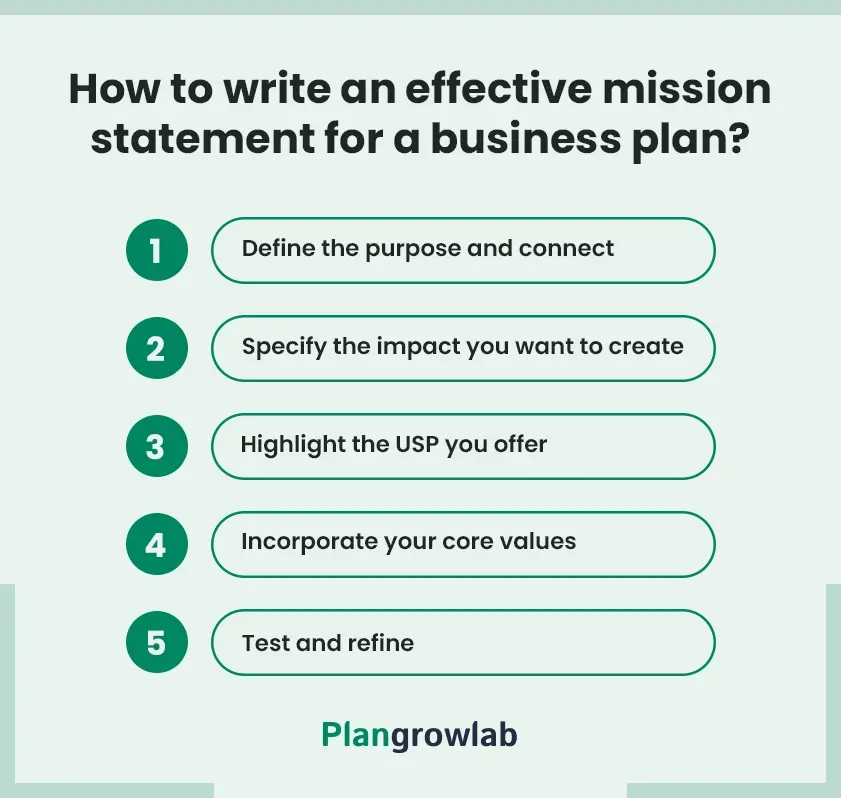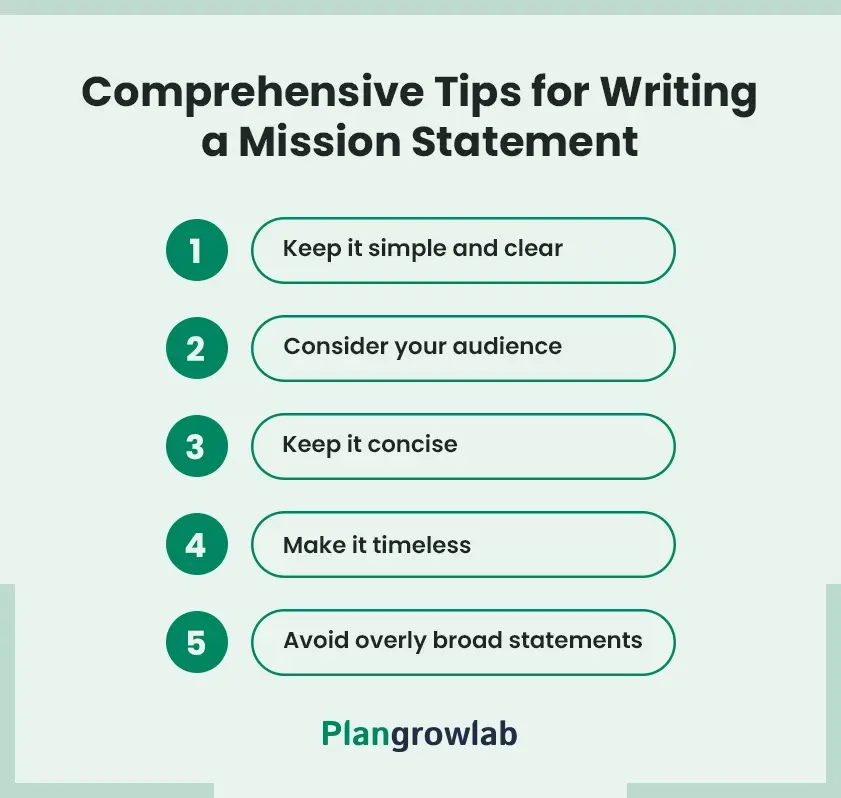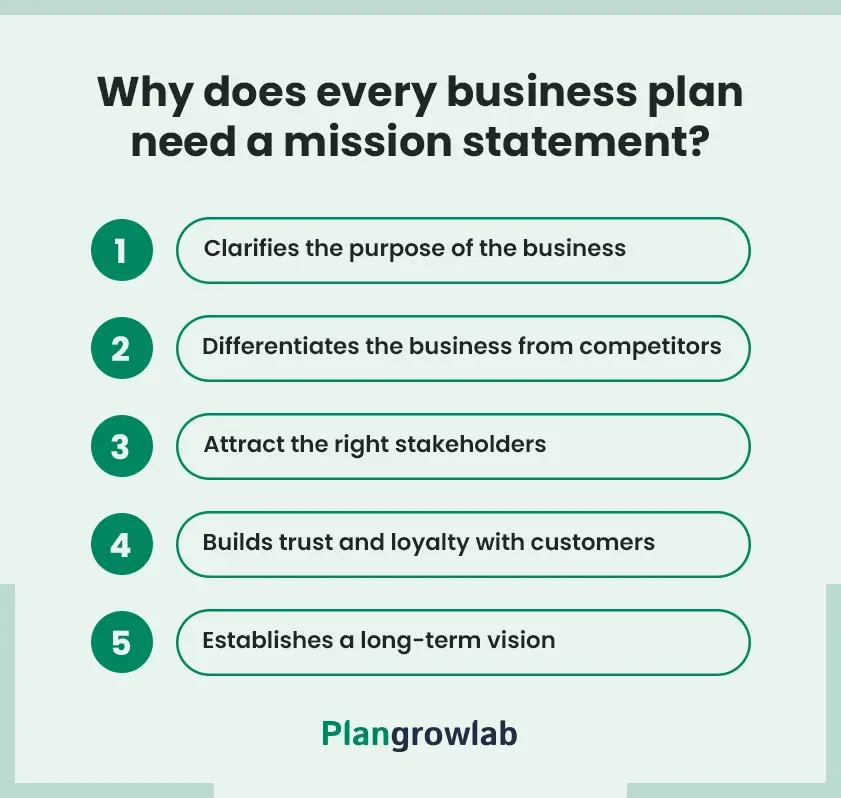Creating a mission statement can feel deceptively simple—after all, it’s just a sentence or two, right? You’d think that.
When you sit down to write, you’ll quickly notice it’s not easy, to sum up everything your business stands for in just a few words. Nor is it easy to make the statement stand out when every company seems to have one.
The truth is that the mission statement writing process isn’t just about words—it’s about strategy.
But what strategy should you follow, and what key elements should you include in your mission statement for a business plan? Worry not; this blog is here to help you.
Let’s dive in and find out the crucial components and strategies to write a mission statement. (Psst! We’ve sprinkled some mission statement examples throughout.)
What is the mission statement?
A mission statement is a concise 1-3 sentence long statement that clearly explains the company’s purpose. It outlines:
- What your company does.
- Why your business exists
- Whom it serves
It communicates the organization's core goals, values, and the impact it aims to make, serving as a guiding principle for decision-making and strategy.
Here are some of the best mission statements:
- Coco-Cola—Refresh the world and make a difference
- L’oreal—Create the beauty that moves the world
- Dolce Gabbana—A code of ethics
How to write an effective mission statement for a business plan?
To write a mission statement is to capture the heart and soul of your business in a single line.
You need to include a clear purpose, a unique value, and a vision that resonates with your audience, and here's how you can do it:

Step 1: Define the purpose of your business and connect
Defining what your company does is crucial because it shapes your brand's identity. But what defines your company? It's your company's ethics, what you'll deliver, and to whom.
Take Coca-Cola, for example. Countless companies are producing carbonated beverages, yet Coca-Cola stands out globally.
Why?
Because it has clearly defined its business and created an emotional connection with its audience.
Look at Coca-Cola's recent advertisements—they aren't just about the product; they focus on building an emotional bond with viewers. Every year, just before December, Coca-Cola launches a campaign, "Holidays are coming," that resonates emotionally with its audience.

This year, they took it a step further by leveraging AI to create a unique ad, yet the core message remains aligned with their mission: "Refresh the world and make a difference."
By defining their purpose and emotionally connecting with their audience, Coca-Cola has established a brand that goes beyond just selling a product—it creates a lasting impact.
Step 2: Specify the impact you want to create
To write a mission statement is to do more than just connect with your audience—it's about defining the impact you intend to create.
Remember, a well-crafted mission statement does more than what your business does; it specifies how your business will make a difference.
Take Microsoft's mission statement, for example. Their mission isn't just about selling software but empowering every organization to "achieve more" through technology.
That simple phrase—"achieve more"—captures the impact they want to create and resonates with their audience emotionally. This is the power of a mission statement: it clearly defines the impact you aim to have, creating a sense of purpose and direction.
Step 3: Highlight the USP you offer
What sets your business apart from competitors?
Your mission statement should reflect and emphasize the distinct value you provide—whether it’s innovation, superior quality, exceptional customer service, or a commitment to social impact. This is your opportunity to communicate what makes your business truly unique.
A well-crafted mission statement highlights your unique selling proposition (USP) and serves as a stepping stone to differentiate your brand in a crowded marketplace. If your mission effectively conveys this uniqueness, you’ve already gained a competitive edge, making it harder for competitors to match your value.
For example:
Apple's mission statement focuses on creating innovative products that provide users with the best possible experience. Their USP is their commitment to high-quality, user-friendly technology that blends design and function seamlessly.
Apple has effectively used its mission statements to highlight its USP, setting it apart and driving its success in competitive industries.
Step 4: Incorporate your core values
Your core values aren’t just nice to have—they shape the foundation of your mission statement. It should reflect the principles that guide your business decisions and shape your company culture.
These values set you apart from competitors and show internal and external stakeholders what you truly stand for.
For example, a mission statement like "To promote ethical sourcing, fair labor practices, and environmental sustainability in every product we create" isn't just a statement.
It communicates the company's commitment to responsible business practices and serves as a guiding framework for everything from choosing suppliers to engaging with customers.
When your mission highlights your core values, it shows what you do and how and why you do it. This clarity builds trust, inspires employees, attracts like-minded customers, and ultimately positions your business for long-term success.
Step 5: Test and refine
Drafting your mission statement is just the first step. You need to test and refine it to ensure it effectively communicates your business's purpose and resonates with your audience.
A great mission statement should sound good on paper and hold up in the real world. Here's how to test and improve it:
- Check for clarity: Ensure your mission statement communicates your business's purpose without ambiguity.
- Assess simplicity and memorability: Keep it concise, easy to understand, and memorable for anyone who reads it.
- Evaluate emotional impact: Ensure it inspires and motivates your team and external stakeholders.
- Ensure alignment with the company’s goals and values: Verify that it reflects your business goals, vision, and core values.
- Gather feedback from stakeholders: Collect input from employees, advisors, and customers to identify areas for improvement.
- Refine and finalize: Use feedback to fine-tune your mission statement, ensuring it remains clear, relevant, and impactful.
Comprehensive tips for writing a mission statement
Sometimes, even a well-written mission statement can fail simply because a few essential basics are overlooked.
To help you avoid that, here are some tried-and-tested tips that have worked for many businesses and can guide you to writing a mission statement that truly delivers:

Keep it simple and clear
You might be tempted to use fancy words or industry jargon, but simplicity wins. A mission statement isn't a place to show off vocabulary; it's about clarity.
You're on the right track if someone can read it once and immediately understand your purpose. Hence, keep your statement:
- Simple yet effective
- Jargon-free
- Easy to remember
Consider your audience
Who are you writing the mission statement for? Is it primarily for internal use to inspire your team, or is it outward-facing for customers and investors? Craft your mission statement accordingly.
For example,
| Focus | Description | Example |
|---|---|---|
| Internal Focus | If your mission aims to inspire and motivate employees, emphasize purpose and company culture. | "To empower our team to innovate and create solutions that make a difference in the world." |
| External Focus | If your mission targets customers and investors, highlight your business's value and broader impact. | "To deliver affordable, eco-friendly technology solutions that improve everyday life." |
The right mission statement speaks directly to the intended audience and ensures it resonates with action.
Keep it concise
A concise mission statement communicates with your audience easily and in a digestible way. Hence, it should not be a long paragraph; the ideal length of a concise statement should be a few words to anything between 2-3 sentences.
The aim to keep your mission statement concise is to:
- Make it quick to recall.
- Convey your business's purpose in a matter of seconds.
- Keep your company aligned with its core purpose.
- Make it easier to incorporate into branding and communications.
Make it timeless
While your business goals and market conditions may change over time, your mission statement should stand the test of time.
Avoid references to trends or short-term objectives. Instead, focus on your enduring purpose and the long-term value you aim to provide.
Making your mission statement timeless means focusing on the value you're offering now and in the future rather than something temporary or subject to change.
Let’s take Microsoft’s and Google’s company mission statements as examples – Originally, Microsoft's mission was focused on technology: "A computer on every desk and in every home."
As the company grew and the world changed, Microsoft expanded its focus. Today, their mission statement is: "To empower every person and every organization on the planet to achieve more."
Google's original mission statement was: "To organize the world's information and make it universally accessible and useful."
Today, Google's parent company, Alphabet, has adopted a broader vision: "To advance technology and apply it to the world's biggest challenges."
Avoid overly broad statements
A good mission statement should be specific, not vague. Broad statements like "We aim to make the world a better place" sound impressive but fail to communicate your business's true purpose.
Instead, narrow your focus and showcase what makes your business unique. It should make an impact clearly, like what the exact change or value you want to create.
Further, mind the following tips while crafting your mission statement:
- Define the exact problem your business addresses.
- Highlight your unique approach or solution.
- Use clear, simple language that anyone can understand.
- Focus on a specific audience or market segment.
- Avoid lofty, generic phrases—be realistic and actionable.
Why does every business plan need a mission statement?
A company's mission statement might seem like a simple addition to a business plan, but its significance goes far beyond a few lines of text.
Here's why:

Clarifies the purpose of the business
A good mission statement clarifies the "why" behind your business. With this statement, stakeholders can easily navigate the purpose of business, whom it serves, and what difference it brings in customers' lives.
This clarity provides stakeholders with a better understanding of key aspects such as:
- Operational plan
- Marketing strategies
- Financial requirements
- Target market insights
With a clear mission, aligning these elements becomes much easier and more effective.
Differentiates the business from competitors
In a crowded market, a business needs to stand out. A mission statement communicates:
- What makes the business unique
- Why it exists beyond making a profit
For example, if two businesses offer similar products, the one with a clear, purpose-driven mission is more likely to attract attention and loyalty from customers and investors.
A mission statement gives your business a unique identity and positions it as a brand with a purpose.
Attract the right stakeholders
Investors and business partners aren't just looking for financial returns—they want to back businesses with a clear vision and purpose.
A mission statement communicates your company's long-term vision and demonstrates:
- Commitment to solving a real problem
- Dedication to ethical and sustainable practices
- Potential for lasting impact
Moreover, businesses with a strong mission statement are more likely to secure funding from investors who share similar values, leading to stronger partnerships and better long-term relationships.
Builds trust and loyalty with customers
Today's customers don’t just buy products—they buy the story behind them. They seek brands that align with their values, and that’s where a strong mission statement makes all the difference.
A mission statement helps build an emotional connection with customers by:
- Communicating the company's values and purpose
- Demonstrating a commitment to making a positive impact
Customers who resonate with your mission are more likely to become loyal advocates, which leads to repeat business, word-of-mouth referrals, and a stronger brand reputation.
Establishes a long-term vision
A business plan outlines the steps to achieve short-term objectives, but a mission statement defines the company's long-term vision. It answers the question: Where do we want to be in the future?
This vision helps guide growth and expansion while ensuring the business stays true to its core values and purpose.
Companies with a clear mission are better equipped to navigate challenges and adapt to changes in the market without losing sight of their ultimate goals.
While working through the process of writing a mission statement, you might find yourself wondering: Is a vision statement the same as a mission statement? The short answer is no.
Let’s see why.
What is the difference between mission and vision statements?
While both define your company's direction, they focus on different aspects—the present and future.
Let's break it down:
| Aspect | Mission Statement | Vision Statement |
|---|---|---|
| Definition | Describes the purpose of your business—what you do and why you do it. | Outlines the future goals and where the company aspires to be in the long term. |
| Focus | Focuses on the present and the current actions that drive the business. | Focuses on the future and the ultimate aspiration of the company. |
| Timeframe | Short to medium-term, reflecting what the company is doing now to achieve success. | Long-term, envisioning where the company wants to be in 5-10 years or more. |
| Use | Primarily used to guide internal decisions and communicate the company’s value to customers. | Inspires and motivates stakeholders by painting a picture of the company’s future. |
| Example | Microsoft: "To empower every person and every organization on the planet to achieve more." | Microsoft: "To help people and businesses throughout the world realize their full potential." |
Bottom line
It's clear that good mission statements aren’t just an exercise—they are powerful tools that define your business's core purpose. In this blog, we've covered mission statement examples, their importance, and how to craft one strategically.
However, writing a mission statement requires expertise, vision, and an understanding of what truly sets your business apart.
This is where professional guidance comes in, and if you're seeking professional advice, you can connect with PlanGrowLab. We offer expert advice on writing impactful mission statements and creating business plans that align with your vision.
Contact us today to get started on your journey toward success.
Frequently Asked Questions
How long should a mission statement be in a business plan?
An effective mission statement should be concise and typically consist a few words to 3 sentences. The goal is to clearly convey the company’s purpose without overwhelming the reader. A concise mission statement reflects clarity and focus, essential for capturing attention.
What are the key elements of a mission statement?
The key elements of a mission statement include:
- Purpose: What your business does.
- Target Audience: Whom you serve.
- Unique Value: How you stand out.
- Impact: The change you aim to create.
These elements ensure the mission statement reflects your company's essence.
Can a mission statement change over time?
Yes, a mission statement can evolve as the business grows, enters new markets, or shifts its focus. Many companies' mission statements are updated to align with new goals, technologies, or customer needs, ensuring continued relevance.
Where should the mission statement be placed in a business plan?
The mission statement is typically placed in the executive summary or company overview section of the business plan. Positioning it early ensures that readers immediately understand the business's core purpose and direction.
What’s the difference between a mission statement and a vision statement?
A mission statement reflects the company’s current purpose and actions, while a vision statement outlines its future goals and aspirations. Both guide decision-making but focus on different timeframes.
Why is a mission statement essential for startups and small businesses?
For startups and small businesses, a mission statement provides direction and clarity. It helps define the business’s purpose, attract investors, align the team, and build a brand identity. Strong mission statements differentiate small businesses in competitive markets.


